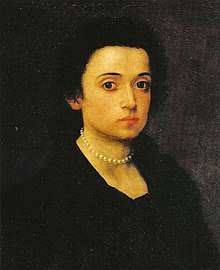Arcangela Paladini
Arcangela Paladini (or Arcangiola Palladini) (Pisa 1599 – Florence 1622) was an Italian painter, singer and poet.
Early life and education

Arcangela Paladini was the daughter of Florentine painter Filippo Paladini (1544–1616), a pupil of Alessandro Allori (1535-1607). Paladini was a contemporary of Baroque painter Artemisia Gentileschi (1593–1656). She may have served as the model for an image of Saint Cecilia, the patron saint of music, painted by Artemisia.[1] Paladini was already an accomplished artist by the time she turned 15.[2] After moving from Pisa to Florence in 1615, she began working under acclaimed Mannerist painter Jacopo Ligozzi.[3]
Relationship with the Medici Dynasty
She initially lived in the monastery of Saint Agatha, where she was supported by the Grand Duchess Maria Maddalena de' Medici, who later became her main benefactor.[4] At age 17, at the suggestion of the Grand Duchess, Paladini married Antwerp-born tapestry-maker Jan Broomans. The Grand Duchess also invited Paladini to serve her at court, and introduced her to her husband Grand Duke Cosimo II.[5] In 1621, Paladini painted a self-portrait for Maria Maddalena, who displayed the painting in her own room.[4] The portrait was later added to the collection displayed in the Vasari Corridor and was restored in 1967.[2] It is the only painting currently identified by the artist.[4]
Death
Paladini died in Florence in 1622 and was buried in the church of Santa Felicità where the Grand Duchess commissioned a tomb memorial, a rare honor.[6] The tomb was sculpted by Agostino Bugiardini and Antonio Novelli.[7] The epitaph compares Paladini to the goddess Athena and the painter Apelles.[4] In 2004 Roman theater director Alberto Macchi published a play he wrote inspired by Paladini’s life story.
References
- ↑ Hanning, Barbara Russano (2004). "From Saint to Muse: Representations of Saint Cecilia in Florence". Music in Art: 98–99.
- 1 2 Fortune, Jane (2010). "Self Portraits by Women in the Vasari Corridor". The Florentine (121).
- ↑ Masera, Maria Giovanna (1943). "Una cantante del seicento alla corte medicea:Arangiola Palladini". Rassegna Musicale. 16: 50.
- 1 2 3 4 Dabbs, Julia K. (2009). Life Stories of Women Artists 1550-1800: An Anthology. Surrey: Ashgate. pp. 298–99.
- ↑ Fortune, Jane (2009). Invisible Women: Forgotten Artists of Florence. Florence: The Florentine Press. pp. 64–65.
- ↑ Orfanello, Teresa (Dec 1999). "Pittrice 'Cantatora'". MAM (46): 31.
- ↑ "Gli Artisti della Compagnia di Santa Barbara". La S.S. Annunziata (2): 6. March–April 2013.